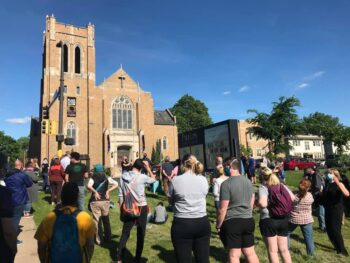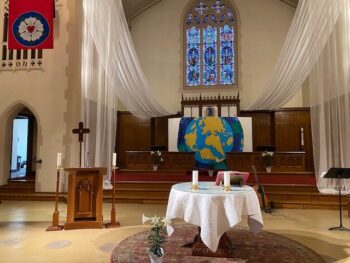By Maya Bryant
On the morning of April 21, 2022, four leaders from Calvary Lutheran Church logged onto a Zoom call to discuss how the way they “do church” is changing. In the last two years, a number of events happened in Calvary’s backyard: the killing of George Floyd just one block from their congregation; a pandemic that forced members physically apart; all while in the middle of a years-long process of selling of their building, which, as of April 20, 2022, is now on the National Register of Historic Places.
Josh Moberg, Calvary’s church council president, said that the congregation is “a small, vibrant, urban church called to engage with [its] immediate neighborhood in an authentic way; ways that support people and meet their needs.”

In the park across the street from Calvary Lutheran
Council member and Calvary Facility Task Force member, Susan Olsen, repeated one word: tenacious. “The people of Calvary have such a deep commitment [to serve their neighbors],” Olsen said.
Founded in 1923, the Calvary congregation serves four neighborhoods in the South Minneapolis community: Bancroft, Bryant, Central, and Powderhorn. Calvary’s website highlights that the members “compassionately care for one another, our neighborhoods, city, world, and all creation.” This commitment became more and more apparent as Calvary members shared the support they’ve given to their congregation and their neighborhood for decades.
“Calvary supports its neighbors through its long-running food shelf, which serves between 80 and 130 families every weekend.”
“I remember things that Calvary did in the community in terms of programmatic services decades and decades ago,” Olsen said. “It just courses through the blood of the membership of this [congregation].”
One of myriad ways that Calvary contributes is through its long-running food shelf, which serves between 80 and 130 families every weekend. It has run for more than 40 years, but with the events of the last two years, “[i]t emerged as a new point of view for community engagement in the time of pandemic and post-George Floyd,” Josh Moberg said. “This is a place where we’ve been doing a lot of background and base-building work in the community for a long time, and we’re positioned to see that develop in a new way.”
Joani Moberg, the chair of the Sustainable Calvary Steering Committee (and former chair of the facility task force) said that Calvary members come together to support their community in times of stress, including recently during the protests of George Floyd’s killing. “We had a community table that we were setting up to support the pilgrimage and the protestors who were coming to George Floyd Square to be in that sacred space. That became an extension of the food shelf, too,” she offered.
COMMUNITY ENGAGEMENT is at the heart of Calvary. So, in 2021, the congregation made a conscious decision to sell their building space. But why sell the building?
This was not the first time Calvary has been at a crossroads to sell or close. “About 25 years ago, Calvary was even closer to closing and was able to move forward with the grace of God by being gifted funds from a member who had passed through benevolence funds,” Church Council member Sarah Shepard said. “[I wonder if] there is a connection between the work that was done then and coming to this point now, making that choice to move forward together.”

Calvary’s sanctuary
Members said that it was a long and intensive process that started when they realized that keeping the building in its current situation was not sustainable. Joani Moberg stated that “[t]he Calvary steering committee decided we were going to network our way out of this.”
“Calvary was learning how to be sustainable as a small congregation in a large and aging building, deep in budgets and tough congregational meetings.”
For months, a task force worked in their neighborhood and community to speak with and learn from as many people and organizations as possible about their needs and wants. “We started by talking to and learning from other churches that had been through transformative processes with their building,” Joani Moberg said. “In our mind, we thought, ‘Is this something we could do? Could we partner with other congregations in our space? Or could we sell our building and share time with other congregations in a different space?’”
In a blog by Emilie Bouvier, the synod’s director of organizing, it was recounted that Calvary was learning “how to be sustainable as a small congregation in a large and aging building, deep in budgets and tough congregational meetings, when the opportunity to partner with Trellis came to us as an incredible answer to prayer.”
Trellis is a nonprofit affordable housing developer that works with organizations and communities to build high-quality living spaces for low-income individuals and families. It has built 50 properties in Minnesota, a majority of them in the Twin Cities area.
Trellis and Calvary plans to build affordable housing spaces, as well as provide supportive service through Simpson Housing Services for people transitioning from unsheltered circumstances.
THE FINAL DECISION TO work with Trellis in particular did not come lightly to the Facility Task Force. Members emphasized the fact that they were approached by and worked with other organizations and consultants before landing where they did, including Tierra Encantada and Proximity Project.
Before deciding to work with Trellis, the task force also connected with projects that Trellis worked on, asking questions about their relationship, the outcomes of their collaboration, and their satisfaction with said outcome.
When it seemed that Trellis was the one for them, they began working with Dan Walsh, the vice president of housing development at Trellis.
“Members said that it was a long and intensive process that started when they realized that keeping the building in its current situation was not sustainable.”
“It’s been a collaborative process because we have the shared vision of Calvary continuing to be a presence onsite as a worshipping community, and as a place of community activity around the food shelf,” said Josh Moberg, “Trellis has really embraced that vision and that’s the core of what makes this vison workable and exciting for us.”
The collaboration between Calvary and Trellis was thriving, and the task force wanted to make sure that the collaboration and communication with the congregation and neighborhood about Trellis and the plans for the building were transparent.

Calvary members holding a vote about the future of their building, even as the pandemic limited in-person, indoor gatherings.
There was a fear – and potentially an expectation – that the building would be torn down due to its age. The task force held forums and meetings to get a sense of what congregants were feeling and invited neighbors to come in and ask questions as well.
“We wanted to make sure that we didn’t preserve ourselves for the sake of preservation,” explained Joani Moberg, “… that we don’t like change because we enjoy getting together, because it’s comfortable, because we’re friends.”
Many group conversations with several notetakers, one-to-ones, and long meetings with Calvary leaders later, it came down to final vote on May 2, 2021. Unanimously, Calvary members decided to sell their building.
“We wanted to make sure that we didn’t preserve ourselves for the sake of preservation.”
“Things have fallen in place in remarkable ways – the spirit of God is working wonderous things,” Olsen said. “But there’s a time and place for buildings to close.”
Despite what would seem like a sad moment for the congregation, there was an air of anticipation and excitement for the newness of change.
“We are as deeply invested in this congregation as has ever been in our 100-year history, and yet we’re also freed from the challenges of caring for an aging building and can focus on care for our neighbors and our community which we’re recognizing as our true call,” said Josh Moberg. “That level of service is what is important to us.”
